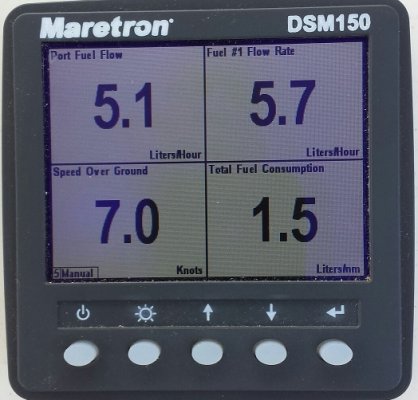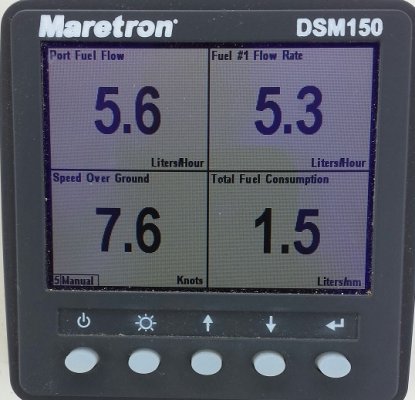I purchased my first larger boat (89 48ft Nova) in June last year. I had completed many hours of research on forums about how much fuel a cruiser of this size would use prior to buying. Definitive answers are not really available as there are simply too many variables. The very first expenditure after settlement day was on the Maretron fuel flow monitor system. With twin 3208AT 375HP CAT's and 20 tonnes of boat I thought the system would be the best investment for us over the life of the boat. People can tell you how many nautical miles they have done this season and how much fuel they used but without a fuel flow monitor you cannot tell how much you are using in real time. By having this knowledge in real time you can save a LOT of money.
I purchased 2 x FFM100's, 4 x M1RSP-2R-E8 fuel flow sensors, 1 x GPS200, 1 x DSM150, and a NMEA2000 starter kit plus a few extra cables. You must have the DSM150, DSM250 or the Nk2 Software and the PC connection to configure the devices. You must have an NMEA2000 GPS to give you the Nautical Miles per litre or gallon readings. Otherwise you can only have litres or gallons per hour.
I installed myself - if you have never done any of this kind of thing before, you do have to read the documentation (and again, and again.....

) relating to what you want to do and then fill in the blanks yourself.
You can display a range of things on the screens. I have attached a couple of examples. You will note from the 2 images that depending on something as simple as a 12 knot wind or current it can affect the speed but you can still maintain a desired fuel burn. Without this kind of system you will think that your best fuel burn is at xknots and sit on that everywhere you go. What I have found is that on any given day my fuel burn at a desired speed can vary by as much as 100%!
We now drive the boat only by the fuel flow monitors and our desired fuel burn - this is a combined 2ltrs per nautical mile. Some days we are doing 12knts in a tidal current and tail wind - other days it can be as low as 6knts.
The only modification I had to make to the equipment out of the box was lengthen the cables for the flow sensors. the FFM100's should not be mounted in the engine room as they should not be in temperatures of greater than 50 deg Celsius. They only come with 1mtr tails on them out of the box.
I would highly recommend purchasing the system - you can add to it over time and take it with you to the next boat (unless you can afford a new boat which will most likely have them!)
Sorry but I do not have experience in outputting the data to an MFD - I have a Raymarine C120 Classic which does not have NMEA2000 connectivity. (apparently possible via Seatalk 2 but I have not found anyone with specific instructions - if anyone knows I am happy to hear from you

)
I hope this is helpful for you.


